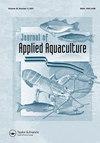Effects of dietary lipid reduction on lipid composition, fatty acid profile, plasma lipoproteins and antioxidant status in gilthead seabream (Sparus aurata)
IF 0.8
Q3 FISHERIES
引用次数: 1
Abstract
ABSTRACT In the aquaculture industry, the transfer of lipids from the diet to fish to consumer is of great importance. Special attention is being given by researchers, feed manufactures and farmers to optimize the use of feeds to provide efficient production and the best use of dietary resources in the growth of healthy and nutritious aquaculture species. In this sense, this study was conducted to investigate the effects of dietary lipid reduction in seabream (Sparus aurata) and to assess whether reducing dietary lipid level could improve the quality of the fish without impairing their welfare. Two diets were formulated containing 20% (control) and 10% (hypolidimic) lipid levels. Fish were fed the formulated diets for nine weeks and sampling was conducted after three, six and nine weeks in order to follow the trend of the different parameters studied according to the rearing period. The results showed that the decreased dietary lipid did not significantly affect fish growth level. The total lipid content, diminished significantly by 11% and 8% after six and nine weeks, respectively, in fish fed on the lower lipid diet compared with fish fed the higher lipid level. Plasma cholesterol (CHOL) and low-density lipoprotein (LDL) were significantly reduced only after nine weeks. The total saturated fatty acid (SFA), total monounsaturated fatty acid (MUFA) and total polyunsaturated fatty acid (PUFA) levels were significantly reduced after six and nine weeks. The oxidative state, as a biomarker welfare was investigated and the results show that catalase (CAT) and superoxide dismutase (SOD) activities and sulfhydryl proteins (PSH) and thiobarbituric acid reactive substances (TBARS) levels were not affected significantly during the study. It may be concluded that, under the experimental conditions, the decrease of dietary lipid levels from 20% to 10% could improve the fish quality without impairing fish welfare.饲料降脂对金颡鱼(Sparus aurata)脂肪组成、脂肪酸谱、血浆脂蛋白和抗氧化能力的影响
本文章由计算机程序翻译,如有差异,请以英文原文为准。
求助全文
约1分钟内获得全文
求助全文
来源期刊

Journal of Applied Aquaculture
Environmental Science-Ecology
CiteScore
3.20
自引率
0.00%
发文量
38
期刊介绍:
The Journal of Applied Aquaculture is a platform for the sharing of practical information needed by researchers to meet the needs of investors, farm managers, extension agents and policy makers working to adapt aquaculture theory to achieve economic and food security objectives in the real world. The journal emphasizes multi-disciplinary research and case studies that propose financially and logistically viable solutions to observable problems.
 求助内容:
求助内容: 应助结果提醒方式:
应助结果提醒方式:


